| URLs in this document have been updated. Links enclosed in {curly brackets} have been changed. If a replacement link was located, the new URL was added and the link is active; if a new site could not be identified, the broken link was removed. |
Electronic Resources Reviews
Science of Synthesis and Houben-Weyl
Head, Chemistry Library
University of Pennsylvania
Philadelphia, Pennsylvania
currano@pobox.upenn.edu
History of Science of Synthesis and Data Content
For many practitioners of synthetic organic chemistry, Houben-Weyl's Methoden der organischen Chemie, published by Georg Thieme Verlag, is a staple review source. Houben-Weyl began publication in 1909 with the first edition, consisting of two volumes and covering literature published as early as 1834. The last volumes of the supplemental E-series were published in 2003. Most volumes are in German; however, several of the more recent sets in the E-series are also available in English-language editions. The four editions and E-series are comprised of 183 volumes and index volumes (Georg Thieme Verlag 2000), and contain 146,000 experimental procedures, 580,000 structures, and 700,000 references (Thieme Chemistry 2007).Since review sources are out-of-date almost as soon as they are published, Thieme decided that updates to Houben-Weyl were needed. Science of Synthesis was born as a result. Science of Synthesis' full title is: Science of Synthesis: Houben-Weyl Methods of Molecular Transformations (Backes et al. 2006). When completed in 2008, it will be a 48 volume set, reviewing more than a century of synthetic chemical literature. Thieme estimates that the completed set will contain over 18,000 experimental synthetic procedures, 180,000 reactions, and about 800,000 structures (Thieme Chemistry 2007).
Science of Synthesis, like the rest of Houben-Weyl, is a review source. One can think of it as a set of review articles, written by authors with an intimate knowledge of their subject matter, which summarize the literature and reference research articles that demonstrate various techniques and transformations. Each volume is edited by an expert in the field, who selects the authors and makes recommendations about the specific contents of the book. This editorial aspect is one of the things that makes a review source valuable to individual researchers. Most databases that scientists employ are traditional indexing and abstracting services; individuals perform searches that return results of varying quality and appropriateness and then must evaluate these results and winnow the wheat from the chaff. In a review source like Science of Synthesis, the winnowing has already been done by the best scientists in the field, which greatly helps the inexperienced researcher just beginning a new project, as well as a savvy user trying to find the best synthetic method to use under specific conditions. The resource is evaluative in nature, indicating key applications of the reactions discussed. In some cases, it even informs the user of applications that will not yield the desired results.
Organizational Structure
Science of Synthesis' overarching hierarchy is based on the product of a reaction, not on the type of reaction or the reagents employed. This is one of the beauties of the resource; it presents multiple techniques for performing the same type of transformation in proximity to one another. A researcher can quickly compare reagents and substrates before settling on the best method of effecting a particular reaction. Each chapter presents background information on the reactions included, as well as appropriate synthetic schema and tables of substrates and results (Georg Thieme Verlag 2001).The volumes of Science of Synthesis are divided into six different themed sets.
- Organometallics
- Heteranes and Related Ring Systems
- Compounds with Four and Three Carbon-Heteroatom Bonds
- Compounds with Two Carbon-Heteroatom Bonds
- Compounds with One Carbon-Heteroatom Bond
- Compounds with All-Carbon Functions
Within each category, information is organized into product classes and then subclasses. A much more detailed description of the classification scheme can be located in the Science of Synthesis Guidebook (Georg Thieme Verlag 2001).
Pricing and Format
Science of Synthesis is available in both hardcover print and electronic format, and pricing for each can be obtained directly from Thieme Chemistry. Online subscribers can also purchase paperback editions of one or more volumes for a price considerably less than that of the hardcover edition. Many Science of Synthesis articles are indexed in Chemical Abstracts, and the many different search options available in the electronic version make the information contained accessible to even novice searchers. The data presented in the print and electronic versions are identical. The features discussed in the following sections are those of the electronic version, although all comments on the content will apply equally to both formats. The new online Version 3.2 was released in August 2006 (Shortt de Hernandez 2007).
System Requirements, Access, and Basic Interface
Science of Synthesis runs on both the OSX Macintosh and the PC platforms. It is a web-based resource that requires no plug-ins or special software to run, although users may choose to draw structures using either a ChemDraw or ISIS/Draw plug-in if they have either of those programs installed on their machines. Users who elect to use the ChemDraw plug-in must have a fully licensed version of ChemDraw on their machines, while ISIS/Draw is available for download from MDL (Backes et al. 2006). For those who prefer not to use either plug-in, structure drawing must be done with a Java applet, meaning that the browser must be configured to allow Java. The most recent release of Science of Synthesis is compatible with all versions of Internet Explorer, as well as Safari and later versions of Mozilla Firefox.On first connecting to the database, the researcher will see the following screen, divided into two frames (Figure 1).
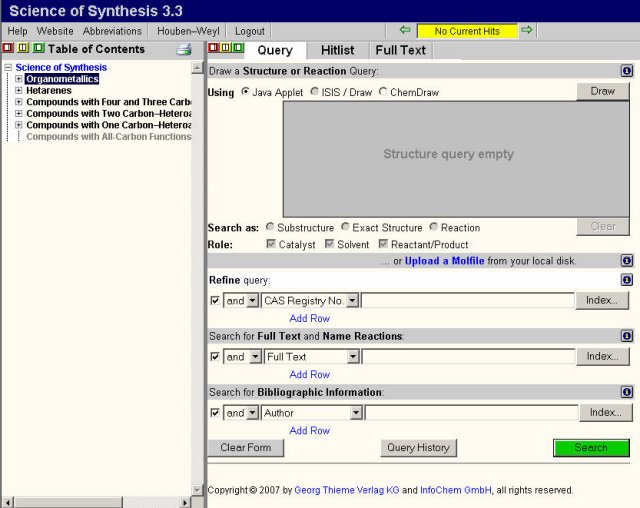
Figure 1: Science of Synthesis Main Screen
The frame on the left is a browsable table of contents, while the search interface and the results display appear in the larger, right section. Either frame can be turned off using the toggle buttons beside either the words "Table of Contents" or the Query tab, causing the remaining section to fill the entire window. The red button turns off the search/display frame and displays only the table of contents; the yellow button activates both frames; and the green button turns off the table of contents, displaying only the search/display screen.
Search Features
Browsing Science of Synthesis Online
The electronic version of Science of Synthesis attempts, wherever possible, to maintain the look and feel of a book, while providing the user with advanced search features that will direct him or her to a reaction or topic of choice. The browsable table of contents (Figure 1), in the left frame, shows the user the organization and hierarchy of the data.The initial entries represent the six major categories of Science of Synthesis data. By clicking on the + sign beside each entry, a user can move within a category to volumes, types of substance, and synthesis/applications of each substance, getting a good idea of the layout of the data within each volume. To read an article of interest, the researcher need only click on a hyperlinked heading to be taken, in the right frame, to the html full text. Unless it is turned off, the table of contents will remain in the left frame throughout all searching and reading activity.
The Query Tab
When a user first launches Science of Synthesis, the contents of the Query tab are immediately displayed in the right frame. There are two basic ways to search Science of Synthesis online: structure searching and text searching.
Structure and Reaction Searching
The structure and reaction search options are, by far, the most prominent in the Query tab taking up a full third of the search screen (Figure 1).The user must first choose one of the three structure editors using the radial buttons above the structure search box. While some researchers prefer using the ISIS/Draw or ChemDraw plug-ins, the Java applet (Figure 2) appears to be the most consistently reliable across platforms. Once he or she has designated a structure editor, the user can click the Draw button to launch the editor of choice.
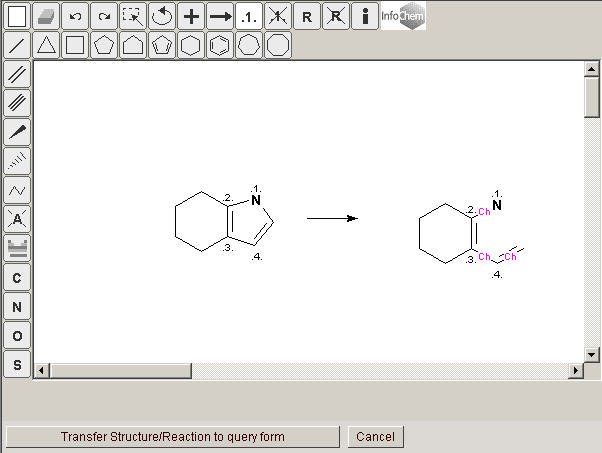
Figure 2: Screen shot of the Java applet structure editor
All three structure editors permit the usual substructure techniques. Because of the review nature of the resource, general substructure searches may be more effective in locating methods than extremely restrictive ones.
- Unsubstituted sites are considered free unless otherwise specified.
- Ring or chain topology of individual bonds can be set by right-clicking on a bond and selecting to the "Edit Bond" menu.
- Valence, charge, or mass may be set on an atom by right clicking on it and selecting the "Edit Atom" menu.
- Users may map atoms from reactant to product in a reaction search.
- R-groups can be used to limit substitutions at a particular site.
Adding and defining R-groups may not be intuitive for users who are not familiar with the ISIS/Draw derivative structure editors (used in the CrossFire/DiscoveryGate databases from MDL), but explanatory text is available in the "Help" document on the product main page (Figure 1). When the structure is complete it can be transferred into the search screen, from which the query is initiated. If the user draws a reaction, the system will automatically select a reaction search; if a single structure is drawn, the user can select whether he or she wants to do an exact structure or substructure search and can set a reaction role (catalyst, solvent, reactant/product) for the substance.
In addition to or in lieu of a structure search, a user can search for a specific substance by CAS Registry number and can also search by catalyst, solvent, reaction yield, and temperature.
Text Searching
The two text fields, "Search for Full Text or Name Reactions" and "Search for Bibliographic Information," are quite useful to researchers desiring either more or less specific information than can be obtained from a reaction or structure search. (See Figure 1).The full text/name reaction search allows users to search for keywords in the full text of an article or for specific named reactions. When doing a name reaction search, it is helpful to make use of the indices provided for more precise searching. To do so, one must simply begin typing the search term within the search box and then click on the little index button. Selecting a term from the resulting table will paste it into the box in the search screen.
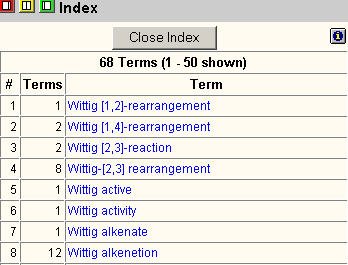
Figure 3: Name Reaction Index
Similar indices exist for each text search field. Additional search terms can be added by clicking on the "add row" link and selecting the appropriate Boolean operators (and, or, not, near) from the pull-down menu. The database allows users to link any number of terms, and truncation is possible, using the * symbol.
"Search for Bibliographic Information" is one of the more cryptic features of the database. The best way to get to a known reference from Science of Synthesis is by using this search option. It is possible to search for the author of an article, as well as the volume and page number on which an article appears; however, in order to include all necessary information, a user must add additional rows to the search screen. If properly constructed, a bibliographic information search should take the user directly to the article of interest, and it is easier and more effective than browsing the table of contents to locate the appropriate chapter. However, this strategy is not intuitive to users accustomed to the clearly-labeled bibliographic search interface used by electronic journals and databases like SciFinder (Scholar) and PubMed.
Query History
The results from any search can be retrieved during the course of a session by clicking on the Query tab and selecting the Query History button. A list of queries and the number of hits each retrieved appears in the left frame of the screen. By selecting a query, the user can paste the search statements and structures into the Query frame and rerun the search. This is a useful feature, as it allows a user to return to previously-viewed results even after he or she has performed several other searches. However, it would be more convenient if the links in the query history took the user directly to the results view of the appropriate hit set.
Search Results
The Hitlist Tab
When the database has performed a search, it takes the user directly to the Hitlist tab, the central tab in the right frame.
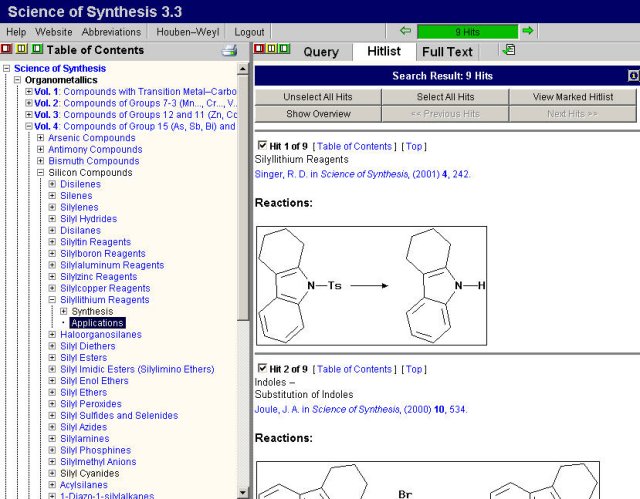
Figure 4: The Hitlist Tab
Within the hit list, the user has two different display options and several additional options.
List view: This is the default view for a set of hits, giving a list of chapters that contain matches to the query text or structures. In a substance or reaction search, a short view of all matching compounds and reactions appear below the bibliographic information. Each hit has three links associated with it.
- Table of Contents: moves a user to the appropriate entry in the browsable table of contents on the left. This is helpful because it allows the user to see the context of the hit and evaluate its possible relevance.
- Top: brings the user to the top of the reference list.
- Bibliographic Reference: takes the user to the appropriate section of text in the Full Text tab.
Show Overview: This option presents the user with a list of volumes of the series and indicates the number of hits that appear in each volume (Figure 8). When the user clicks on the first hit from a specific volume, it scrolls him or her to the appropriate hit in the hit list.
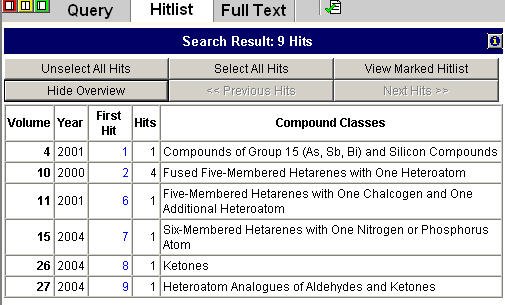
Figure 5: The Hitlist Tab with "Show Overview" Selected
There are several other options presented in the initial results screen.
- Move forward and backward through a large hit set
- Select specific hits of interest (by checking the box beside the bibliographic information)
- Unselect all hits
- Display only selected hits
The Full Text Tab
Once a user has selected a reference from the Hitlist tab, he or she is presented with the appropriate section of the html full text in the Full Text tab (Figure 5). In the case of a structure or reaction search, the user should be taken directly to the structure or reaction of interest, which is boxed in yellow. Other search terms are also highlighted in yellow.
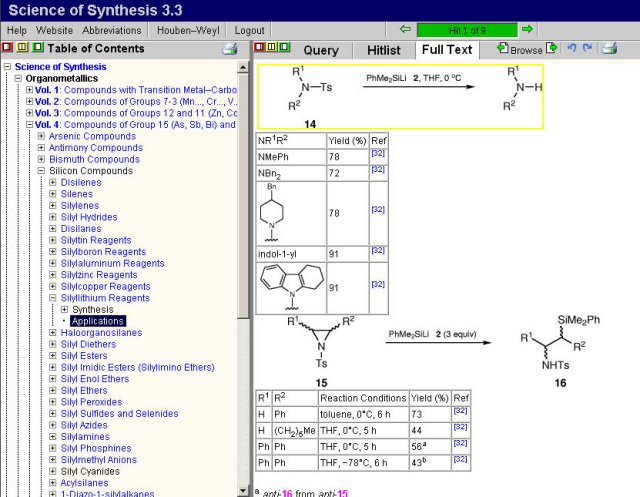
Figure 6: The Full Text Tab
The hits are fairly easily navigated once the first has been opened. To move forwards or backwards in the volume in which the selected result appears, one can use the Browse buttons. To move forward or backward through the hit list, one need only click on the button beside the hit number.
Manipulating Results
Saving and Exporting Hits
Since Science of Synthesis is actually an online book, there is no option to save the full text of references. The database providers assume that, if a researcher wishes to view the chapter at a later date, he or she will either rerun the original search or do a bibliographic information search to retrieve the chapter. There also does not appear to be a good way to export references retrieved to reference management software, something that should probably be considered in future releases.
Linking to References
A bibliography for each article follows the article text. The reference numbers are hot-linked within the text and, when clicked, will zoom the user to the appropriate reference in the bibliography. The bibliographic references are also hot-linked, and will take a user to a menu of options for accessing the text of the article.
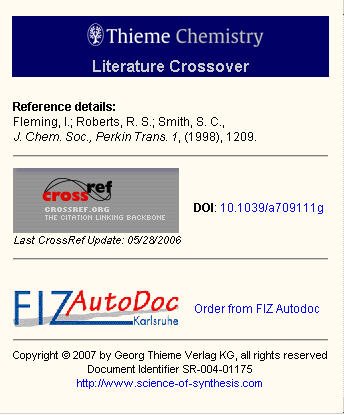
Figure 7: Linked Article Full-Text Options
If an article is CrossRef enabled, a CrossRef link will appear. In addition, some articles will link to the CAS ChemPort or to PubMed, from whence subscribers can access the full-text of the article. There is also a link to purchase the article from FIZ. Often, it can take as many as three different clicks before getting to the full text. The help file does not indicate that linking to the journals can be done through SFX or a similar link resolver, which would be a very nice feature.
Printing Articles or Sections
Printing a single subsection of Science of Synthesis is fairly straightforward and only requires the user to click on the printer icon in the right frame. However, if a user wishes to print an entire section of a volume, including all of its subsections, the procedure is slightly opaque. One must select the section that he or she wishes to print by clicking on its entry in the table of contents and then clicking the print icon just above the table of contents. (See Figure 1).This prints the highlighted section and all of its subsections, to a maximum of fifty sections total. This method is certainly not intuitive, although it is definitely better than printing each of the subsections separately. It was added at the request of the user community.
Houben-Weyl
Around the time that they launched Science of Synthesis online, Thieme also introduced scanned PDF images of all previous volumes in the Houben Weyl series. There are two methods of accessing the ninety years of Houben-Weyl preceding the Science of Synthesis volumes. At the end of each section of Science of Synthesis, any overlap sections in other volumes of Houben-Weyl are hot-linked. The text of Houben-Weyl is also searchable on its own. One simply needs to click the Houben-Weyl button at the top of the window to be taken to the search interface for this work.
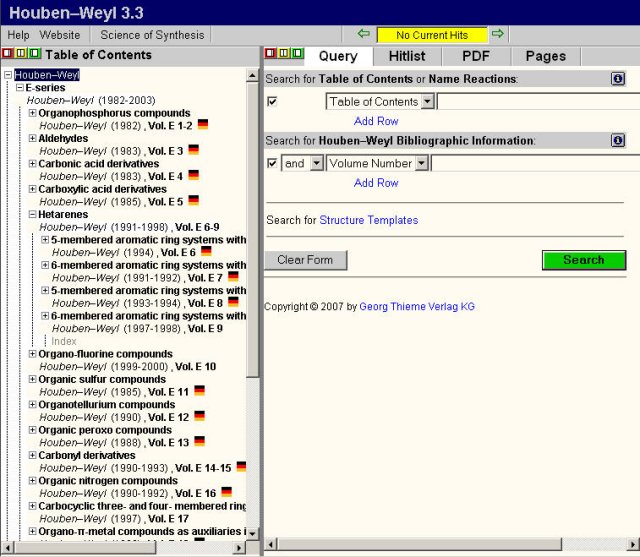
Figure 8: Online Houben-Weyl Interface
Houben-Weyl will open in a separate window. Like Science of Synthesis, Houben-Weyl has a browsable table of contents, which has been translated into English. A German flag appears beside each volume that is in the German language; there is no flag beside English-language volumes.
Searching Houben-Weyl
Because the resource consists of scanned documents enhanced by the metadata from the table of contents, Houben-Weyl's search features are very limited. One can search through the text of the chapter titles and headings or named reactions, or one can perform the same type of bibliographic information search as in Science of Synthesis to access a known article. The most interesting method of searching, by far, is the structure template search (Figure 9), accessible by clicking the hot-link below the text boxes. This allows users to specify the type of structure for which they are searching and returns a list of volumes in which such structures appear.
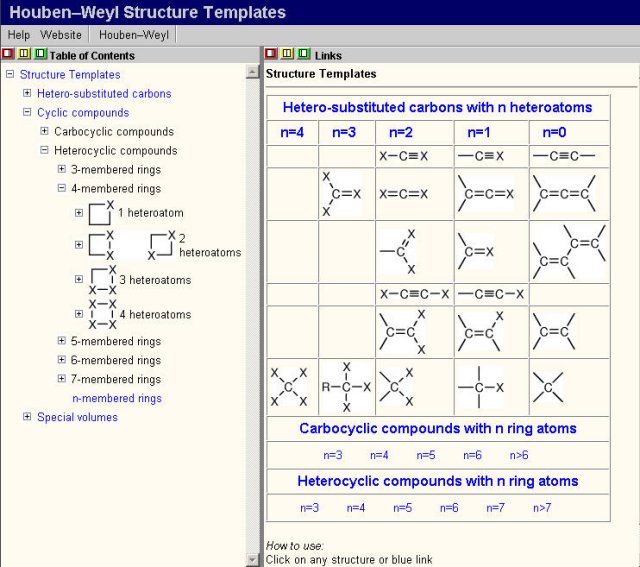
Figure 9: Houben-Weyl Structure Templates
Help and Support Features
The main help document for Science of Synthesis is a PDF file with bookmarks that clearly describe each section of the document and make for easy navigation. In addition, the text of the document is fully searchable using the "find" feature in Adobe Acrobat, so, it is easy to locate strings of text that are of interest.In addition to the help file, there are also many little "i" icons presented beside the various search and display tools. When a user clicks the icon, a short description of the tool and some useful tips appear just below the icon (Figure 1). Clicking the icon again removes this text
Although both the help file and the in-context help are clearly written and explain the features of the database quite well, better integration of the two would be of great assistance to the user. Perhaps links from the in-context help to the appropriate sections of the PDF help file would make it easier for the user to get more in-depth assistance, when desired. A link from the Java applet to the section of the help file dealing with structure search, would also be much better than forcing the user to return to the main Science of Synthesis window, select the help file, and find the part of the help file that deals with structure drawing.
Conclusions
Science of Synthesis and Houben-Weyl are extremely important and useful review sources for synthetic chemists. Unlike most databases, they provide an overview of the synthetic literature and evaluate specific reactions and methods used for a variety of purposes. Any strong organic synthesis collection would be enhanced by this resource. By reading the review articles contained, researchers can save a great deal of time that would otherwise have been spent performing searches and wading through a vast quantity of articles to find the best synthetic method for a particular transformation. Although the quirks of the interface can be irritating at times, the functionality is generally good, and the quality of the information contained makes up for any difficulties in obtaining it. If funds can be spared in these times of troubled budgets, Science of Synthesis is an excellent investment.
For more information contact:
Georg Thieme Verlag KG
Rudigerstrasse 14
D70469 Stuttgart
marketing@thieme-chemistry.com
References
Backes, J., et al. 2006. Science of Synthesis Getting Started Manual. [Online]. Available: {https://www.thieme.de/statics/dokumente/thieme/final/en/dokumente/sw_%20thieme-connect/SoS-40-Quick-Start-Guide.pdf} [Accessed April 16, 2007].Georg Thieme Verlag. 2000. Houben-Weyl Methods of Organic Chemistry Users' Guide. Stuttgart; New York, Georg Thieme Verlag.
Georg Thieme Verlag. 2001. Science of Synthesis Guidebook, 5th Edition. Stuttgart; New York, Georg Thieme Verlag.
Shortt de Hernandez, M. Fiona. 2007. Science of Synthesis Version 3.2. Science of Synthesis News. February 2007. [Online]. Available: {http://www.science-of-synthesis.com/thieme-chemistry/sos/info/show_pdf.html?thieme-chemistry/sos/info/include/pdf/nl2007_spring.pdf} [Accessed April 16, 2007].
Thieme Chemistry. Online Products. Science of Synthesis. 2007. [Online]. Available: {http://www.science-of-synthesis.com/thieme-chemistry/sos/info/online/body.shtml} [Accessed July 15, 2007].
| Previous | Contents | Next |
